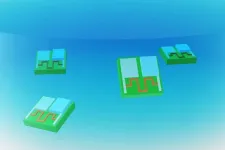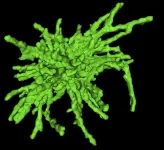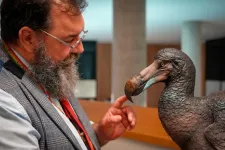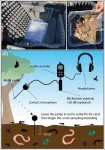(Press-News.org)
A tiny battery designed by MIT engineers could enable the deployment of cell-sized, autonomous robots for drug delivery within in the human body, as well as other applications such as locating leaks in gas pipelines.
The new battery, which is 0.1 millimeters long and 0.002 millimeters thick — roughly the thickness of a human hair — can capture oxygen from air and use it to oxidize zinc, creating a current of up to 1 volt. That is enough to power a small circuit, sensor, or actuator, the researchers showed.
“We think this is going to be very enabling for robotics,” says Michael Strano, the Carbon P. Dubbs Professor of Chemical Engineering at MIT and the senior author of the study. “We’re building robotic functions onto the battery and starting to put these components together into devices.”
Ge Zhang PhD ’22 and Sungyun Yang, an MIT graduate student, are the lead author of the paper, which appears in Science Robotics.
Powered by batteries
For several years, Strano’s lab has been working on tiny robots that can sense and respond to stimuli in their environment. One of the major challenges in developing such tiny robots is making sure that they have enough power.
Other researchers have shown that they can power microscale devices using solar power, but the limitation to that approach is that the robots must have a laser or another light source pointed at them at all times. Such devices are known as “marionettes” because they are controlled by an external power source. Putting a power source such as a battery inside these tiny devices could free them to roam much farther.
“The marionette systems don’t really need a battery because they’re getting all the energy they need from outside,” Strano says. “But if you want a small robot to be able to get into spaces that you couldn’t access otherwise, it needs to have a greater level of autonomy. A battery is essential for something that’s not going to be tethered to the outside world.”
To create robots that could become more autonomous, Strano’s lab decided to use a type of battery known as a zinc-air battery. These batteries, which have a longer lifespan than many other types of batteries due to their high energy density, are often used in hearing aids.
The battery that they designed consists of a zinc electrode connected to a platinum electrode, embedded into a strip of a polymer called SU-8, which is commonly used for microelectronics. When these electrodes interact with oxygen molecules from the air, the zinc becomes oxidized and releases electrons that flow to the platinum electrode, creating a current.
In this study, the researchers showed that this battery could provide enough energy to power an actuator — in this case, a robotic arm that can be raised and lowered. The battery could also power a memristor, an electrical component that can store memories of events by changing its electrical resistance, and a clock circuit, which allows robotic devices to keep track of time.
The battery also provides enough power to run two different types of sensors that change their electrical resistance when they encounter chemicals in the environment. One of the sensors is made from atomically thin molybdenum disulfide and the other from carbon nanotubes.
“We’re making the basic building blocks in order to build up functions at the cellular level,” Strano says.
Robotic swarms
In this study, the researchers used a wire to connect their battery to an external device, but in future work they plan to build robots in which the battery is incorporated into a device.
“This is going to form the core of a lot of our robotic efforts,” Strano says. “You can build a robot around an energy source, sort of like you can build an electric car around the battery.”
One of those efforts revolves around designing tiny robots that could be injected into the human body, where they could seek out a target site and then release a drug such as insulin. For use in the human body, the researchers envision that the devices would be made of biocompatible materials that would break apart once they were no longer needed.
The researchers are also working on increasing the voltage of the battery, which may enable additional applications.
The research was funded by the U.S. Army Research Office, the U.S. Department of Energy, the National Science Foundation, and a MathWorks Engineering Fellowship.
###
Written by Anne Trafton, MIT News
Paper: “High energy density picoliter-scale zinc-air microbatteries for colloidal robotics”
https://www.science.org/doi/10.1126/scirobotics.ade4642
END
Studying cell migration is vital because it plays a crucial role in many biological processes, including immune response, wound healing, and cancer metastasis. Understanding how cells move and behave can lead to breakthroughs in treating diseases, developing new drugs, and creating innovative therapies. For example, in cancer research, tracking how cancer cells migrate can reveal how tumors grow and spread through the human body. This insight can led to the discovery of more efficient and targeted treatments to stop or even prevent metastasis.
Scientists have introduced CellTracksColab, a tool that simplifies cell tracking data analysis. This free platform leverages advanced ...
Researchers at Utrecht University in the Netherlands have identified a new way in which the toxic protein aggregates associated with Huntington’s disease may damage nerve cells and cause them to die. The study, to be published August 16 in the Journal of Cell Biology (JCB), suggests that the aggregates can poke holes in the membrane that separates the nucleus from the rest of the cell, damaging the DNA inside the nucleus and changing the activity of neuronal genes.
Huntington’s disease is a devastating neurogenerative disorder caused by a mutation in the HTT gene that results in cells producing abnormally large versions of the huntingtin protein. These ...
The Colorado River and its tributaries provide water for hydropower, irrigation and drinking water in seven U.S. states and Mexico. Much of this water comes from the snowpack that builds up over the winter and then melts each spring. Every year in early April, water managers use the snowpack to predict how much water will be available for the upcoming year.
But since 2000, these predictions have been incorrect, with the actual streamflow being consistently lower than the predicted streamflow. That’s left water managers ...
On May 11, a gorgeous aurora surprised stargazers across the southern United States. That same weekend, a tractor guided by GPS missed its mark.
What do the visibility of the northern lights have in common with compromised farming equipment in the Midwest?
A uniquely powerful geomagnetic storm, according to two newly published papers co-authored by Virginia Tech's Scott England.
“The northern lights are caused by energetic, charged particles hitting our upper atmosphere, which are impacted by numerous factors in space, including the sun,” said England, associate professor in the Kevin T. Crofton Department of Aerospace and Ocean Engineering. “During ...
COLUMBUS, Ohio – A new national study provides the best evidence to date that generous unemployment insurance benefits during the COVID-19 pandemic helped reduce reliance on high-cost credit use.
Researchers found that lower-income residents of states with more generous benefits were significantly less likely than those living in less-generous states to take out new credit cards, personal finance loans and payday loans or other alternative financial service offerings.
The study, published recently in the journal ...
With new medications on the market or in the works for Alzheimer’s disease and other kinds of dementia, a new study suggests that getting the diagnosis needed to access these new treatments may depend on where you live.
The percentage of people who get a new dementia diagnosis each year varies a lot across regions of the U.S., the study finds.
And the differences between regions of the country are even larger for people on the young end of the dementia-risk age range, ages 66 to 74, and for those who are Black ...
August 16, 2024
The Banana Apocalypse is Near, but UMass Amherst Biologists Might Have Found a Key to Their Survival
Discovery of molecular mechanisms used by the banana-destroying microbe brings hope to the breakfast table
AMHERST, Mass. – The bananas in your supermarket and that you eat for breakfast are facing functional extinction due to the disease Fusarium wilt of banana (FWB) caused by a fungal pathogen called Fusarium oxysporum f.sp. cubense (Foc) tropical race 4 (TR4). However, thanks to recent research from an ...
Rethinking the Dodo
Review of 400 years of scientific literature corrects the record on icon of extinction
Researchers are setting out to challenge our misconceptions about the Dodo, one of the most well-known but poorly understood species of bird.
In a paper published today [16 August 2024] in the Zoological Journal of the Linnean Society researchers from the University of Southampton, Natural History Museum (NHM) and Oxford University Museum of Natural History have undertaken the most comprehensive review of the taxonomy of the Dodo and its closest relative, the Rodriguez ...
Could arts and crafts help protect the public’s mental health? A new study in Frontiers in Public Health provides evidence that indulging our creative side could provide everyone with a significant wellbeing boost. Because arts and crafts are relatively affordable and accessible, promoting the public’s access to artistic activities could provide a major boost to public mental health.
“Crafting and other artistic activities showed a meaningful effect in predicting people’s ...
Barely audible to human ears, healthy soils produce a cacophony of sounds in many forms – a bit like an underground rave concert of bubble pops and clicks.
Special recordings made by Flinders University ecologists in Australia show this chaotic mixture of soundscapes can be a measure of the diversity of tiny living animals in the soil, which create sounds as they move and interact with their environment.
With 75% of the world’s soils degraded, the future of the teeming community of living species that live underground face a dire future without restoration, says microbial ecologist Dr Jake Robinson, from the Frontiers ...







